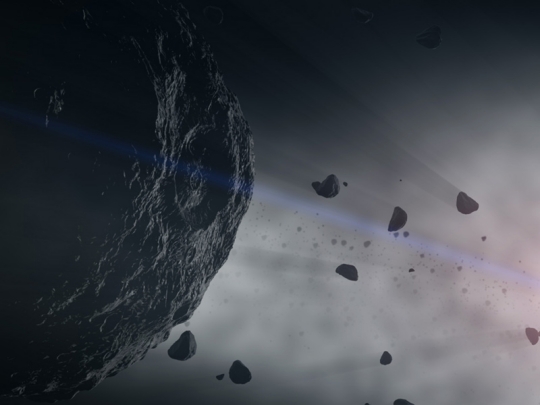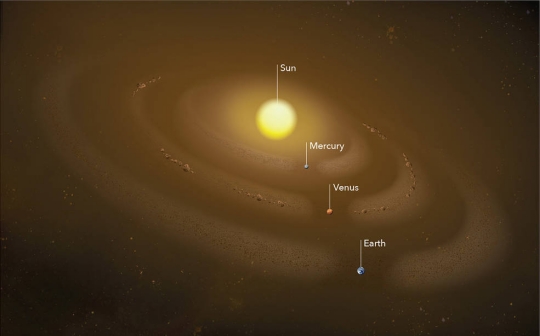Dust rings in the Solar System are of interest because they offer clues about the formation of the planets, as well as allowing us to contrast our own circumstellar dust with what we see around other stars in varying stages of planetary development. Recent work out of NASA’s Goddard Space Flight Center offers a dust ring with a difference from others we’ve found in our own system. Scientists have traced a dust ring near the orbit of Venus, and it’s one with origins different than the dust that occurs in Earth’s orbit as well as dust found near Mercury.
Explaining what is going on in Earth’s orbital path has us resort to the asteroid belt between Mars and Jupiter, where the collisions of small objects create a steady source of dust. The material drifts gradually toward the Sun, but some of it, moving near the Earth, is drawn into our planet’s orbit. A surprising amount of dust falls to Earth each day (one recent estimate is fully 60 tons of the stuff), and the mechanism seems a natural explanation for what we see at Venus.
But the explanation fails. The problem is that simulations of dust moving toward the Sun undertaken by GSFC astrophysicist Petr Pokorný produce a dust ring around the Earth but fail to generate one as dusty as the one around Venus. That sets up a series of simulations that Pokorný, working with colleague Marc Kuchner, have recently discussed in the Astrophysical Journal Letters. Their hypothesis: There exists a group of still undetected asteroids that orbit the Sun co-orbitally with Venus. Collisions between these over time account for the added dust.

Image: Asteroids represent building blocks of the Solar System’s rocky planets. When they collide in the asteroid belt, they shed dust that scatters throughout the system, which scientists can study for clues to the early history of planets. Credit: NASA’s Goddard Space Flight Center Conceptual Image Lab.
A new population of asteroids offers an interesting observational challenge, but the dust ring involved is known to be large, about 26 million kilometers (16 million miles) thick and 10 million kilometers (6 million miles) wide. Even so, this is fairly diffuse material, only about 10 percent denser with dust than surrounding space, and accounting for it has been a challenge. The researchers tried modeling everything from long-period comets to main belt asteroids to explain it.
If asteroids move co-orbitally with Venus, perhaps in its orbit but often on the other side of the Sun, they may have gone undetected because of the difficulty in observing objects this faint so close to our star. Modeling different potential resonances, Pokorný and Kuchner find only a group of asteroids matching Venus’ orbits one for one would reproduce the dust ring.
The researchers work from the premise that this hypothesized group of asteroids has been there since the beginning of the Solar System. Modeling this scenario with a starting group of 10,000 asteroids produced a present-day population of fewer than a thousand, enough to explain the dust ring we see today. Finding such survivors will take an instrument like Hubble, but it will help us nail down the size of the population as well as its physical characteristics.
Dust rings seem to be common, given that we also have strong evidence of a dust ring around Mercury, as demonstrated by Guillermo Stenborg and Russell Howard (Naval Research Laboratory, Washington DC), who present evidence of cosmic dust in a ring some 15 million kilometers (9.3 million miles) wide over Mercury’s orbit. In a region presumed to be free of dust because of its proximity to the Sun, this ring was found using data from the STEREO satellite (Solar and Terrestrial Relations Observatory) and has implications for data gathering by the Parker Solar Probe, now operating in a highly elliptical orbit around the Sun.
“It wasn’t an isolated thing,” Howard said. “All around the Sun, regardless of the spacecraft’s position, we could see the same five percent increase in dust brightness, or density. That said something was there, and it’s something that extends all around the Sun.”

Image: In this illustration, several dust rings circle the Sun. These rings form when planets’ gravities tug dust grains into orbit around the Sun. Recently, scientists have detected a dust ring at Mercury’s orbit. Others hypothesize the source of Venus’ dust ring is a group of never-before-detected co-orbital asteroids. Credit: NASA’s Goddard Space Flight Center/Mary Pat Hrybyk-Keith.
So the solar wind and magnetic forces from the Sun have failed to sweep away the dust found at Mercury’s orbit. As we work to refine our dust models, distinguishing between coronal light and light reflecting off dust in space (which is some 100 times brighter), we’re learning how to separate out the dust signature, which is how the researchers made their unexpected discovery. “It wasn’t an isolated thing,” says Howard. “All around the Sun, regardless of the spacecraft’s position, we could see the same five percent increase in dust brightness, or density. That said something was there, and it’s something that extends all around the Sun.”
Is there a zone of dust-free space close to the Sun, as originally assumed? If so, its boundary will tell us something about the dust’s composition, with implications for early planet formation. Learning how dust near the Sun behaves should occupy scientists with the Parker Solar Probe mission as they witness first hand the environment through which their spacecraft moves.
The papers are Pokorný & Kuchner, “Co-orbital Asteroids as the Source of Venus’s Zodiacal Dust Ring,” Astrophysical Journal Vol. 873, No. 2 (12 March 2019). Abstract; and Stenborg et al., “Evidence for a Circumsolar Dust Ring Near Mercury’s Orbit,” Astrophysical Journal Vol. 868, No. 1 (21 November 2018). Abstract.



What does this dust say about commercial traffic in the Solar System going forward? Will that traffic be moving fast enough that this dust puts it at risk or will it just be an irritant that causes ships to be retired sooner than they otherwise would be?
Just another reason we need a GOOD space telescope, orbiting as close to the Sun as feasible, and pointed out, to detect all the stuff we can’t from Earth, because we’re either looking at its shadowed side, or trying to look past the glare of the Sun.
It’s needed to detect dangerous asteroids, but would also be handy for things more on the science than the planetary defense side of things.
Agree completely Brett. How about a trio of space telescopes orbiting in Venus’ Lagrangian points L2, 4 & 5?
L4 – Venus equilateral?
The Venusian L4 & L5 zones would be where the planet’s supposed trojan asteroids would be. Granted these wouldn’t be a threat to Earth, but telescopes there would be perfectly placed to study them (Venus trojans) and Venus itself, as well as finding threats to Earth.
Do all the other planets also have dust rings in their orbits: Mars, Jupiter etc?
My guess would be that they would Mary, but these rings really just amount to weak (only 5-10% was mentioned) increases in the overall dust in our system’s planetary plane.
I’ve never seen it myself, but this zodiacal dust is even visible to the unaided eye at certain times of the night, if you happen to be at an extremely dark site. See zodiacal light.
This 60 tons or so of dust per day raining down on Earth has a beneficial role to play in our weather and on life here. Those tiny dust grains help water droplets form, so they increase cloud formation and precipitation.
Also the dust provides minerals that benefit plants and microbes in soil and sea.
Well, the actual reason is Vulcan ran into one of the asteroids and was blown to smithereens.
Neith, the lost satellite of Venus.
Vulcan: The lost intramercurial planet.
Objects crossing the Sun.
From the following books;
1. Mysterious Universe, A handbook of astronomical anomalies.
2. The moon and planets.
3. The sun and solar system debris.
Compiled by: William R. Corliss
Or the other possibility: Cannibalized Von Neumann and Bracewell probes. :-)
So we definitely need to put some telescopes up there!!!
The final piece of the puzzle of Jupiter’s inward migration in the Grand Tack hypothesis is in place: JUST OUTSIDE URANUS’ CURRENT ORBIT! Go to https://www.portaltotheuniverse.org and click on: 24 Mar 2019 22:15 UTC “Jupiter’s Unknown Journey Revealed.” for details.